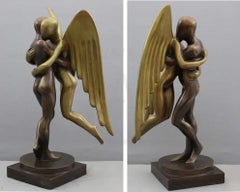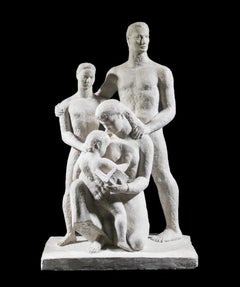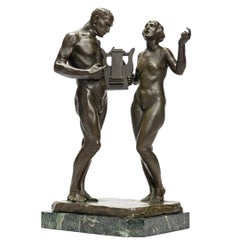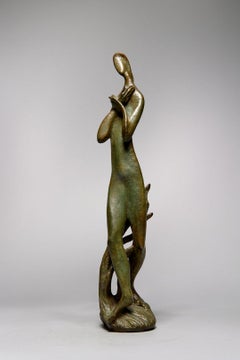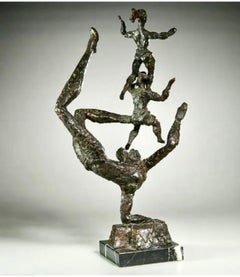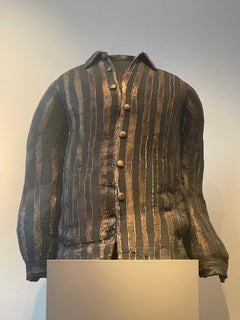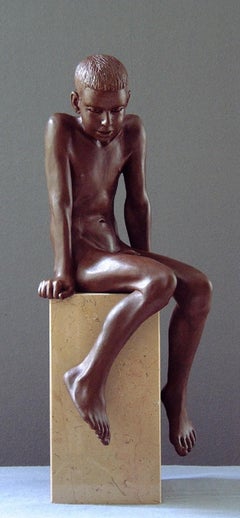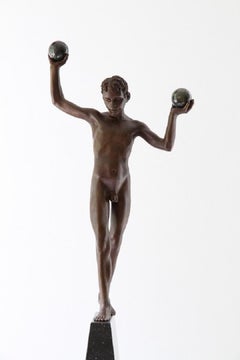American Modern Nude Sculptures
to
1
8
4
3
Overall Width
to
Overall Height
to
12
3
2
2
1
2
1
472
76
71
21
15
7
6
5
5
3
2
2
11
9
7
6
4
3
2
2
1
1
1
1
1
1
1
1
1
1
12
12
2
2
2
2
2
1
1
1
13
2
Style: American Modern
Mark Kostabi - Divine Embrace - Bronze Sculpture
By Mark Kostabi
Located in Winterswijk, NL
Mark Kostabi - Divine Embrace - Bronze sculpture
Divine Embrace is a unique bronze sculpture by renowned artist Mark Kostabi, featuring two faceless figures in an intimate embrace...
Category
21st Century and Contemporary American Modern Nude Sculptures
Materials
Bronze
"Pioneer Family" WPA American Modernism Plaster Maquette Realism 20th Century
Located in New York, NY
"Pioneer Family," 23 1/2 x 16 1/4 x 10 3/4 inPlaster. c. 1927. Unsigned. Realism
The Smithsonian has a cast of this sculpture in its collection. Pictured on the cover of “The Sculpt...
Category
1920s American Modern Nude Sculptures
Materials
Plaster
Harmony, 20th century bronze & green marble base, nude man and woman with lyre
By Max Kalish
Located in Beachwood, OH
Max Kalish (American, 1891-1945)
Harmony, c. 1930
Bronze with green marble base
Incised signature on right upper side of base
14 x 9 x 5 inches, excluding base
17 x 10 x 8 inches, including base
Born in Poland March 1, 1891, figurative sculptor Max Kalish came to the United States in 1894, his family settling in Ohio. A talented youth, Kalish enrolled at the Cleveland Institute of Art as a fifteen-year-old, receiving a first-place award for modeling the figure during studies with Herman Matzen. Kalish went to New York City following graduation, studying with Isidore Konti...
Category
1930s American Modern Nude Sculptures
Materials
Marble, Bronze
Vernal Equinox, 20th Century Bronze Figure of Woman, Cleveland School Artist
Located in Beachwood, OH
Edris Eckhardt (American, 1905-1998)
Vernal Equinox, c. 1975
Bronze
Signed on base
16.5 x 4 x 3 inches
Born in Cleveland, Ohio January 28, 1905, Edris was given the name Edythe Alin...
Category
1970s American Modern Nude Sculptures
Materials
Bronze
Large Chaim Gross Mid Century Mod Bronze Sculpture Circus Acrobats WPA Artist
By Chaim Gross
Located in Surfside, FL
Chaim Gross (American, 1904-1991)
Patinated cast bronze sculpture,
Three Acrobats,
signed
mounted on black marble plinth
24.5"h x 14"w x 7"d (bronze alone)
Chaim Gross (March ...
Category
Mid-20th Century American Modern Nude Sculptures
Materials
Marble, Bronze
Large Ceramic Clay Sculpture Of Striped Shirt In Man Size On Piedestal
Located in Frederiksberg C, DK
Large sized sculpture of a standing shirt including large piedestal.
Category
Late 20th Century American Modern Nude Sculptures
Materials
Ceramic, Clay
2 Sculptures: "The Power" & "The Glory" WPA Depression WWII era mid 20th century
Located in New York, NY
2 Sculptures: "The Power" & "The Glory" WPA Depression WWII era mid 20th century by Agnes Yarnall circa 1940s.
Sculptor, painter, poet and artistic historian, Agnes Yarnall has, since the age of six been breathing life into her art.
Renowned as a sculptor, whose commissioned portrayals of contemporary celebrities are prized. She has sculpted Judith Anderson, Edna St. Vincent Millay, Carl Sandburg...
Category
1940s American Modern Nude Sculptures
Materials
Plaster
Woman Seated A Bronze Sculpture of a Woman by Charles Rumsey
Located in Brookville, NY
The bronze sculpture of a woman by Charles Rumsey is undated, but was created at a point in his career where he began to transition from realism to more modern, looser depictions of ...
Category
1920s American Modern Nude Sculptures
Materials
Bronze
Bronze Female Nude Sculpture Modernist, WPA, New York Chelsea Hotel Artist
By Eugenie Gershoy
Located in Surfside, FL
Eugenie Gershoy (January 1, 1901 – May 8, 1986) was an American sculptor and watercolorist. Eugenie Gershoy was born in Krivoy Rog, Russia (Krivoi Rog, Ukraine) and emigrated to New York City in the United States as a child in 1903. Considered somewhat of a child prodigy, Gershoy was copying Old Master drawings at the age of 5. Her interest and talent in art was encouraged from a very young age. Aided by scholarships, she studied at the Art Students League under Alexander Stirling Calder, Leo Lentelli, Kenneth Hayes Miller, and Boardman Robinson. Around this time, she created a group of portrait figurines of her fellow artists, including Arnold Blanch, Lucile Blanch, Raphael Soyer, William Zorach, Concetta Scaravaglione, and Emil Ganso, which were exhibited as a group at the Whitney Museum of American Art. At age 17, she was awarded the Saint-Gaudens Medal for fine draughtsmanship. Early in her career she became an active member of the Woodstock art colony. In Woodstock she experimented by sculpting in the profusion of indigenous materials that she found. Working with fieldstone, oak and chestnut, Gershoy created works based on classic formulae. As she became more interested in the dynamism of everyday life, she found that these materials and her idiom were too restrictive. By the time Gershoy came to Woodstock in 1921 her own individual artistic style was already evident in her sculptures. Eugenie Gershoy worked in stone, bronze, terracotta, plaster and papier-mache. Gershoy’s sculptures were mainly figurative in nature and many of her artist peers such as Carl Walters, Raphael and Moses Soyer, William Zorach and Lucille Blanch, became her subjects. Eugenie Gershoy’s works on paper should not be overlooked. She was the winner of the Gaudens Medal for Fine Draughtsmanship at the tender age of 17. Gershoy married Jewish Romanian-born artist Harry Gottlieb. In the late 1920s and early 1930s, the pair kept a studio in Woodstock, New York. There, Gershoy was influenced by sculptor John Flanagan, who lived and worked nearby.
From 1936 to 1939, Gershoy worked for the WPA Federal Art Project. She collaborated with Max Spivak on murals for the children's recreation room of the Queens Borough Public Library in Astoria, New York. She developed a mixture of wheat paste, plaster, and egg tempera, which she used in polychrome papier-mâché sculptures; she was the only New York sculptor to work in polychrome at this time. She also designed cement and mosaic sculptures of animals and figures to be placed in New York City playgrounds. Alongside others employed by the FAP, she participated in a sit-down strike in Washington, DC, to advocate for better pay and improved working conditions for the projects' artists.
Gershoy's first solo exhibition was held at the Robinson Gallery in New York in 1940. She moved to San Francisco in 1942, and began teaching ceramics at the California School of Fine Arts in 1946. In 1950, she studied at the artists' colony at Yaddo.
Gershoy traveled extensively throughout her life. She visited England and France in the early 1930s, and worked in Paris in 1951. She traveled to Mexico and Guatemala in the late 1940s, and also toured Africa, India, and the Orient in 1955.
In 1977, Gershoy dedicated a sculpture to Audrey McMahon, who was actively involved in the creation of the Federal Art Project and served as its regional director in New York, in recognition of the work McMahon provided struggling artists in the 1930s.
Gershoy's work is in the collections of the Whitney Museum of American Art, the Metropolitan Museum of Art, and the Smithsonian American Art Museum. Her papers are held at Syracuse University Grant Arnold introduced her to lithography in 1930 and Gershoy depicted many scenes of Woodstock artists and their daily activities through this medium. From 1942 to 1966 Gershoy lived and painted in San Francisco where she taught at the San Francisco Art Institute. She traveled extensively, filling sketchbooks with scenes of Mexico, France, Spain, Africa and India. During her later years Eugenie Gershoy returned to New York City and concentrated on numerous well received exhibitions. Her last exhibition in at Sid Deutsch Gallery included many of the sculptures that were later exhibited in the Fletcher Gallery.
John Russell, former chief critic of fine arts for the New York Times, writes about the 1986 Sid Deutsch exhibition:
“As Eugenie Gershoy won the Saint-Gaudens Medal for fine draftsmanship as long ago as 1914 and since 1967 has had 15 papier-mache portrait figures suspended from the ceiling of the lobby of the Hotel Chelsea, she must be ranked as a veteran of the New York scene. Her present exhibition includes not only the high-spirited papier-mache sculptures for which she is best known but a group of small portraits of artists, mostly dating from the 30’s, that is strongly evocative.”
Eugenie Gershoy is an artist to take note of for several reasons. She was a woman who received great awards and recognition during a time when most female artists were struggling to hold their own against their male counterparts. As a young girl she won a scholarship to the Arts Student League where she met Hannah Small...
Category
Mid-20th Century American Modern Nude Sculptures
Materials
Bronze
Reclining Boy
Located in Boston, MA
Initialed and dated: "DVT 61". From the estate of the artist. In fine condition.
Category
Mid-20th Century American Modern Nude Sculptures
Materials
Bronze
LADY AND SCOTTISH DOG
Located in Pasadena, CA
Magnificent beautiful masterpiece bronze sculpture of lady with the Scottish Deer Hunter dog bronze comes with green patina; 1/10
So beautiful and a lot...
Category
2010s American Modern Nude Sculptures
Materials
Bronze
$5,200 Sale Price
20% Off
1961 Coty Award Plaque Kenneth Hairdresser Jacqueline Onassis Bronze Fashion
Located in New York, NY
1961 Coty Award Plaque Kenneth Hairdresser Jacqueline Onassis Bronze Fashion
Bronze on wood. The wood plaque measures 12 3/4" by 20 3/4 inches. The bronze plaque itself is 13 3/4 x 8 3/4 inches and the the bronze inscription, which reads "COTY, American Fashion Critics Special Award 1961 to KENNETH of LILY DACHE...
Category
1960s American Modern Nude Sculptures
Materials
Bronze
Chaim Gross Mid Century Mod Bronze Sculpture Balancing WPA Artist Mom and Child
By Chaim Gross
Located in Surfside, FL
Chaim Gross (American, 1904-1991)
Patinated cast bronze sculpture,
Balancing, Mother and child
signed and editioned 1/6
mounted on black marble plinth
14"h x 11.5"w x 8"d (height w...
Category
1960s American Modern Nude Sculptures
Materials
Bronze
Nude Walking, Early 20th Century Bronze Sculpture, Cleveland School Artist
By Max Kalish
Located in Beachwood, OH
Max Kalish (American, 1891-1945)
Nude Walking, 1930
Bronze
Signed and dated on base
17 x 9 x 4 inches
Born in Poland March 1, 1891, figurative sculptor Max Kalish came to the United States in 1894, his family settling in Ohio. A talented youth, Kalish enrolled at the Cleveland Institute of Art as a fifteen-year-old, receiving a first-place award for modeling the figure during studies with Herman Matzen. Kalish went to New York City following graduation, studying with Isidore Konti and Herbert Adams...
Category
1930s American Modern Nude Sculptures
Materials
Bronze
Modern Bronze Relic Sculpture of figure with 3 legs: 'Rhoman Fertility Goddess'
By Joshua Goode
Located in New York, NY
Inspired by amateur archaeologists such as Heinrich Schliemann who discovered Troy and by past elaborate hoaxes like that of the Piltdown Man, Joshua travels the world performing sta...
Category
2010s American Modern Nude Sculptures
Materials
Bronze
Related Items
Ira Bronze Sculpture Contemporary Nude Boy Marble Stone Sitting
Located in Utrecht, NL
Ira Bronze Sculpture Contemporary Nude Boy Marble Stone Sitting
Wim van der Kant (1949, Kampen) is a selftaught artist. Next to his busy profession a...
Category
21st Century and Contemporary American Modern Nude Sculptures
Materials
Marble, Bronze
$9,128
H 14.57 in W 3.94 in
Tollit Bronze Sculpture Nude Boy Contemporary Male Figure Balance Marble Stone
Located in Utrecht, NL
Tollit Bronze Sculpture Nude Boy Contemporary Male Figure Balance Marble Stone
Wim van der Kant (1949, Kampen) is a selftaught artist. Next to his bu...
Category
21st Century and Contemporary American Modern Nude Sculptures
Materials
Marble, Bronze
Wim van der KantTollit Bronze Sculpture Nude Boy Contemporary Male Figure Balance Marble Stone, 1999
$13,633
H 20.08 in W 13.78 in
Finis Saltationis Bronze Sculpture Nude Boy Male Figure Marble Stone
Located in Utrecht, NL
Finis Saltationis Bronze Sculpture Nude Boy Male Figure Marble Stone
This sculpture need to be ordered. We will cast a b...
Category
21st Century and Contemporary American Modern Nude Sculptures
Materials
Marble, Bronze
$32,902
H 31.5 in W 11.82 in
Life Size Female Torso
Located in Brooklyn, NY
TWELVE CHAIRS GALLERY
Zura – Life‑Size Female Figure (2023), Plaster
Dimensions: 39 × 16 × 12 in │ 99 × 41 × 30 cm
Medium: Hand-modeled plaster (also available in bronze)
Signature: ...
Category
2010s American Modern Nude Sculptures
Materials
Bronze
Seated Nude Woman Sculpture, Early 20th Century
Located in Beachwood, OH
William Zorach (American, 1887-1966)
Seated Woman
Painted plaster
Inscribed underside "V"
12.5 x 9 x 5 inches
Provenance: The Tatti Family Collection
Bill Zorach was born in Lithuan...
Category
Early 20th Century American Modern Nude Sculptures
Materials
Plaster
Kneeling Female Nude, Bronze By Mario Korbel
Located in Norwood, NJ
Joseph Mario Korbel (Czech/American, 1882-1954). Period fine example bronze, dark brown patina, modeled as a nude female kneeling and tying her sandal, raised on a stepped black marb...
Category
Early 20th Century American Modern Nude Sculptures
Materials
Marble, Bronze
1961 Coty Award Plaque Kenneth Hairdresser Jacqueline Onassis Bronze Fashion
Located in New York, NY
1961 Coty Award Plaque Kenneth Hairdresser Jacqueline Onassis Bronze Fashion
Bronze on wood. The wood plaque measures 12 3/4" by 20 3/4 inches. The bronze plaque itself is 13 3/4 x 8 3/4 inches and the the bronze inscription, which reads "COTY, American Fashion Critics Special Award 1961 to KENNETH of LILY DACHE...
Category
1960s American Modern Nude Sculptures
Materials
Bronze
RECLINGING WOMAN
Located in Los Angeles, CA
ANTONIUCCI VOLTI
"RECLINGING WOMAN"
BRONZE, SIGNED, NUMBERED 2/6
VALSUANI FOUNDRY
ITALiAN, WORKED IN PARIS, C.1960
6.5 X 18.5 X 10.5 INCHES
Antoniucci Volti
1915-1989
Sculptor, painter, and printmaker Antoniucci Volti was born in Albano, Italy, in 1915. His family lived in Italy until 1920 when the family moved to France.
Volti studied at the Ecole des Arts Décoratifs in Nice from 1928 to 1920. By 1932 the young artist had won a gold medal for two polychrome bas-reliefs before going to Paris, where he entered the studio of Jean Boucher at the Ecole Nationale des Beaux-Arts in Paris at the age of only fifteen.
After serving in the Second World War, when he was interned as a prisoner of war in Bavaria, he returned in poor health to Paris, only to find his studio destroyed.
From 1947 he showed work at various Paris Salons and, in 1954 and 1955 at the Brussels and Antwerp Biennales. In 1957 a retrospective of his work was organized at the Museum Rodin in Paris.
He died in Paris in 1989 Works by Volti are in leading museums such as the Musée National d'Art Moderne, Paris. Antoniucci Volti is one of the most important Late Modern...
Category
1960s American Modern Nude Sculptures
Materials
Bronze
Woman Seated A Bronze Sculpture of a Woman by Charles Rumsey
Located in Brookville, NY
The bronze sculpture of a woman by Charles Rumsey is undated, but was created at a point in his career where he began to transition from realism to more modern, looser depictions of ...
Category
1920s American Modern Nude Sculptures
Materials
Bronze
$6,000
H 10.5 in W 11 in D 6 in
Allegorical mythological figurative bronze from the 19th century
Located in Florence, IT
Marble-based bronze statuette depicting Cupid, holding an arrow in his hand, walking caressing a lion's mane, lowered in the act of affectionately licking his little foot. The subjec...
Category
Mid-19th Century American Modern Nude Sculptures
Materials
Marble, Bronze
$1,797
H 5.12 in W 6.3 in D 3.15 in
Profundus Bronze Sculpture Nude Boy Contemporary Male Figure Marble Stone
Located in Utrecht, NL
Profundus Bronze Sculpture Nude Boy Contemporary Male Figure Marble Stone
Wim van der Kant (1949, Kampen) is a selftaught artist. Next to his busy p...
Category
21st Century and Contemporary American Modern Nude Sculptures
Materials
Marble, Bronze
$16,454
H 22.05 in W 22.05 in
Pair of 19th century scagliola sculptures (Italian Neoclassicism) - Roman figure
Located in Varmo, IT
Pair of scagliola sculptures - Roman figures. Italian manufacture, 19th century.
51 x 26 x h 118 cm (left) - 41 x 28 x h 118 cm (right).
Made entirely of scagliola. Depicting two f...
Category
Early 19th Century American Modern Nude Sculptures
Materials
Plaster
$5,751 Sale Price
20% Off
H 46.46 in W 20.08 in D 10.24 in
Previously Available Items
Industrial Machine Age American Scene WPA Mid 20th Century 1939 SF World's Fair
Located in New York, NY
Industrial Machine Age American Scene WPA Mid 20th Century 1939 SF World's Fair
HAIG PATIGIAN (American/Armenian, 1876-1950)
Aeronautics Pediments
Two Plaster Casts, c. 1930s
each 13.25 x 14.75 x 6 inches
It's possible these moquettes were created for the 1939 World's Fair, the Golden Gate International Exhibition in San Francisco.
Provenance: Private Collection of Lois M. Wright, Author of "A Catalogue of the Life Works of Haig Patigian, San Francisco Sculptor, 1876-1950),” 1967
Loan to Oakland Museum of California (Oakland, CA)
BIO
Haig Patigian is noted for his classical works, which are especially numerous in public venues in San Francisco, California. Patigian was born in Van, Armenia, which at that time was under Turkish rule. Haig was the son of Avedis and Marine Patigian, both teachers in the American Mission School there. He and his older brother showed an aptitude for art early on and were encouraged by their parents. Their father himself had taken up the new hobby of photography. The 1880s were harsh times, however, for many Armenians under an oppressive rule by the Turkish government. Many people were fleeing to the safety of the United States. Suspicious Turkish authorities accused his father of photographing city structures for the Russian government, and in 1888 he fled for his life to America.
Haigs father made his way to Fresno, California, and began life anew as a ranch hand. Within two years he sent for his wife, as well as Haig, his three sisters and brother, and in 1891 the Patigians made the journey from Armenia. Haigs father, an industrious man, worked on various farms, and eventually bought his own ranch and vineyard. It was among fertile farmland of Fresno that Haig grew up.
Young Haigs education consisted of teachings by his parents and by intermittent attendance in public schools. Although he had dreams of becoming an artist, he did not have the opportunity for formal study of art, and began working long days in the vineyards around Fresno.
At age seventeen, Haig made a step towards his dreams and apprenticed himself to learn the trade of sign painting. In his spare time he nurtured his interest in art by painting nature and life scenes with watercolors and oil paints. When his sign-painting mentor left Fresno, Haig opened his own shop and made a name for himself in the town. San Francisco, in the meantime, had been attracting artists since the Gold Rush and had become a thriving art center. Within a few years, Haig had put aside several hundred dollars to move to San Francisco, joining his brother who was already working there as an illustrator.
In 1899, when he was twenty-three, Haig had saved enough money to enroll at the Mark Hopkins Art Institute in San Francisco. Like many aspiring artists of his time, Patigian supported himself by working as a staff artist in the art department of a local newspaper, and in the winter of 1900, nearing his 24th birthday, Haig began work for the San Francisco Bulletin, producing cartoons, black and white illustrations, as well as watercolors.
In 1902 tragedy struck Haig and his family. His 29-year-old brother died of pneumonia, and then his frail mother died a short time later. Five months more saw his youngest sister, just out of high school, die too. Saddened and depressed, Haig moved out of the studio he had shared with his brother, and into a dilapidated studio in a poor section of town. During this time of sadness, Haig fed a growing interest in sculpture.
In 1904 Haig created what he later called his "first finished piece in sculpture". The work, called "The Unquiet Soul", depicted a man thrown back against a rock while waves lash at his feet. The body was tense and twisted, with one hand, in Haig's own words, "searchingly leaning and clutching the rock, while the other masks his troubled head".
The Press Club of San Francisco, which Haig had joined in 1901, put "The Unquiet Soul" on exhibition and local headlines proclaimed "Local Newspaper Artist Embraces Sculptor's Art", and "First Work Predicts Brilliant Future". With the support of friends and community acclaim, the young illustrator left his newspaper job and became a professional sculptor.
The path of his new career was not easy though. Haig had never made much money working for the newspaper and his father needed help with growing debt from funeral expenses and business problems. From time to time Haig sold some artwork, but also occasionally borrowed from friends to pay the rent. He was the classic 'starving artist'.
In the spring of 1905 a white-bearded 81-year-old stranger knocked on Haig's door. It was George Zehndner, from Arcata, California. Zehndner had been born in Bavaria, Germany in 1824, the son of a farmer. In 1849 he had come to America looking for prosperity, settling in Indiana, where he worked on a farm and learned English. He found his way to the West Coast in 1852. Penniless, he worked in various jobs from San Francisco to Sacramento, then found some luck working in the gold fields of Weaverville in Trinity County, and eventually moving to a farm on 188 acres near Arcata. In his 77th year in May of 1901, Zahndner had taken a trip to San Jose, where he stood in a crowd to see a man he thought much of, President William McKinley. McKinley was popular as 'the first modern president' partially because he realized going out to meet the common person increased his support. In September of that year, however, an anarchist assassinated the president while he stood in a receiving line at the Pan-American Exhibition in Buffalo, New York. Soon after, the city of San Jose erected a statue of the slain president in St. James Park. Zehndner took a second trip to San Jose where he visited the McKinley monument. Touched, Zehndner decided that, no matter the cost, his town of Arcata too would memorialize McKinley.
George Zehndner had read about Haig in a newspaper article and asked if Patigian would create a heroic statue of the late President McKinley for Arcata. When asked how much it would cost, Haig responded, despite his borderline poverty, with the fabulous sum of $15,000. Zehndner agreed. The President was to be portrayed standing, wearing an overcoat, with his feet planted squarely on the ground. In the finished statue, one hand is held out before him in a typical posture of speaking, with the other hand holding the speech as his side. The 9-foot statue...
Category
1930s American Modern Nude Sculptures
Materials
Plaster
Large Chaim Gross Mid Century Mod Bronze Sculpture Circus Acrobats WPA Artist
By Chaim Gross
Located in Surfside, FL
Chaim Gross (American, 1904-1991)
Patinated cast bronze sculpture,
Three Acrobats,
signed
mounted on black marble plinth
24.5"h x 14"w x 7"d (bronze alone)
Chaim Gross (March 17, 1904 – May 5, 1991) was an American modernist sculptor and educator.
Gross was born to a Jewish family in Austrian Galicia, in the village of Wolowa (now known as Mezhgorye, Ukraine), in the Carpathian Mountains. In 1911, his family moved to Kolomyia (which was annexed into the Ukrainian USSR in 1939 and became part of newly independent Ukraine in 1991). When World War I ended, Gross and brother Avrom-Leib went to Budapest to join their older siblings Sarah and Pinkas. Gross applied to and was accepted by the art academy in Budapest and studied under the painter Béla Uitz, though within a year a new regime under Miklos Horthy took over and attempted to expel all Jews and foreigners from the country. After being deported from Hungary, Gross began art studies at the Kunstgewerbeschule in Vienna, Austria shortly before immigrating to the United States in 1921. Gross's studies continued in the United States at the Beaux-Arts Institute of Design, where he studied with Elie Nadelman and others, and at the Art Students League of New York, with Robert Laurent. He also attended the Educational Alliance Art School, studying under Abbo Ostrowsky, at the same time as Moses Soyer and Peter Blume.
In 1926 Gross began teaching at The Educational Alliance, and continued teaching there for the next 50 years. Louise Nevelson was among his students at the Alliance (in 1934), during the time she was transitioning from painting to sculpture. In the late 1920s and early 1930s he exhibited at the Salons of America exhibitions at the Anderson Galleries and, beginning in 1928, at the Whitney Studio Club. In 1929, Gross experimented with printmaking, and created an important group of 15 linocuts and lithographs of landscapes, New York City streets and parks, women in interiors, the circus, and vaudeville. The entire suite is now in the collection of the Philadelphia Museum of Art. Gross returned to the medium of printmaking in the 1960s, and produced approximately 200 works in the medium over the next two decades. For more than sixty years Chaim Gross's art has expressed optimistic, affirming themes, Judaica, balancing acrobats, cyclists, trapeze artists and mothers and children convey joyfulness, modernism, exuberance, love, and intimacy. This aspect of his work remained consistent with his Jewish Hasidic heritage, which teaches that only in his childlike happiness is man nearest to God.
In March 1932 Gross had his first solo exhibition at Gallery 144 in New York City. For a short time they represented Gross, as well as his friends Milton Avery, Moses Soyer, Ahron Ben-Shmuel and others.
Gross was primarily a practitioner of the direct carving method, with the majority of his work being carved from wood. Other direct carvers in early 20th-century American art include William Zorach, Jose de Creeft, and Robert Laurent. Works by Chaim Gross can be found in major museums and private collections throughout the United States, with substantial holdings (27 sculptures) at the Hirshhorn Museum and Sculpture Garden. A key work from this era, now at the Smithsonian American Art Museum, is the 1932 birds-eye maple Acrobatic Performers, which is also only one and one quarter inch thick.
In 1933 Gross joined the government's PWAP (Public Works of Art Project), which transitioned into the WPA (Works Progress Administration), which Gross worked for later in the 1930s. Under these programs Gross taught and demonstrated art, made sculptures that were placed in schools and public colleges, made work for Federal buildings including the Federal Trade Commission Building, and for the France Overseas and Finnish Buildings at the 1939 New York World's Fair. Gross was also recognized during these years with a silver medal at the Exposition universelle de 1937 in Paris, and in 1942, with a purchase prize at the Metropolitan Museum of Art's "Artists for Victory" exhibition for his wood sculpture of famed circus performer Lillian Leitzel.
In 1949 Gross sketched Chaim Weizmann, President of Israel, at several functions in New York City where Weizmann was speaking, Gross completed the bust in bronze later that year. Gross returned to Israel for three months in 1951 (the second of many trips there in the postwar years) to paint a series of 40 watercolors of life in various cities. This series was exhibited at the Jewish Museum (Manhattan) in 1953.
In the 1950s Gross began to make more bronze sculptures alongside his wood and stone pieces, and in 1957 and 1959 he traveled to Rome to work with famed bronze foundries including the Nicci foundry. At the end of the decade Gross was working primarily in bronze which allowed him to create open forms, large-scale works and of course, multiple casts. Gross's large-scale bronze The Family, donated to New York City in 1991 in honor of Mayor Ed Koch, and installed at the Bleecker Street Park at 11th street, is now a fixture of Greenwich Village. In 1959, a survey of Gross's sculpture in wood, stone, and bronze was featured in the exhibit Four American Expressionists curated by Lloyd Goodrich at the Whitney Museum of American Art, with work by Abraham Rattner, Doris Caesar, and Karl Knaths. In 1976, a selection from Gross's important collection of historic African sculpture, formed since the late 1930s, was exhibited at the Worcester Art Museum in the show The Sculptor's Eye: The African Art Collection of Mr. and Mrs. Chaim Gross. Gross was elected into the National Academy of Design as an Associate member, and became a full Academician in 1981. In 1984, he was inducted into the American Academy of Arts and Letters, with Jacob Lawrence and Lukas Foss. In the fall of 1991, Allen Ginsberg gave an important tribute to Gross at the American Academy of Arts and Letters, which is published in their Proceedings. In 1994, Forum Gallery, which now represents the Chaim Gross estate, held a memorial exhibition featuring a sixty-year survey of Gross's work.
Gross was a professor of printmaking and sculpture at both the Educational Alliance and the New School for Social Research in New York City, as well as at the Brooklyn Museum Art School, the MoMA art school, the Art Student's League and the New Art School (which Gross ran briefly with Alexander Dobkin...
Category
Mid-20th Century American Modern Nude Sculptures
Materials
Marble, Bronze
H 26 in W 14.5 in D 7 in
Breton Wrestlers Bronze Figurative Modern Male Sculpture Female Artist LGBT WPA
Located in New York, NY
Breton Wrestlers Bronze Figurative Modern Male Sculpture Female Artist LGBT '29 WPA
Malvina Hoffman (American, 1885 - 1966) BRETON WRESTLERS, 20 inche...
Category
1920s American Modern Nude Sculptures
Materials
Bronze
Malvina HoffmanBreton Wrestlers Bronze Figurative Modern Male Sculpture Female Artist LGBT WPA, 1929
H 20 in W 6.5 in D 5.25 in
"Bust of a Woman", Patina Bronze, Nude Female, Signature Cast In
Located in Detroit, MI
"Bust of a Woman", is a bronze sculpture by the Mexican artist, Victor Salmones. This sophisticated piece has an aura of repose and quiet enhanced by the smooth beautiful patina sur...
Category
Mid-20th Century American Modern Nude Sculptures
Materials
Bronze
H 25 in W 11.5 in D 9 in
Seated Nude Woman
Located in Pasadena, CA
Bronze Sculpture with Black Patina, signature Dora Navon date 1982
Category
1980s American Modern Nude Sculptures
Materials
Bronze
LOVERS American Scene Modern Sculpture WPA Mid-Century Modernism Female Artist
By Anita Weschler
Located in New York, NY
LOVERS American Scene Modern Sculpture WPA Mid-Century Modernism Female Artist
Anita Weschler (1903 – 2000) "Lovers," 14 ½ h x 8 x 8 inches, plus a 3 i...
Category
1940s American Modern Nude Sculptures
Materials
Cast Stone
Female Torso
Located in Pasadena, CA
Helaine Dorothy Blum (b. 1909-d. 2010)
A sculptor, she was born on July 13, 1909 in Cleveland, Ohio and died on January 15, 2010 in Santa Monica, California.
Education: Cleveland Ar...
Category
20th Century American Modern Nude Sculptures
Materials
Bronze
Male Nude Grey Marble Sculptue
Located in Lake Worth Beach, FL
Male Nude Figure, dated 1991, signed gray marble sculpture.
Norma Goldberg New York artist born 1928-2005
Category
1990s American Modern Nude Sculptures
Materials
Marble
KNEELING WOMAN modern mid-century modernist WPA carved wood sculpture
By Jose de Creeft
Located in New York, NY
Jose De Creeft (1884-1982)
Kneeling Woman
14” high x 6 1/2” x 6”
carved wood, signed on the base.
Starting from his humble beginnings in Spain to his early international success in ...
Category
1940s American Modern Nude Sculptures
Materials
Wood
H 14 in W 6.6 in D 6 in
Ceramic figurative relic: We Get Stronger In The Broken Places'
By Ashley Benton
Located in New York, NY
Ashley Benton is a mixed media artist working in acrylics, oil, watercolor, wax, resin, plaster, clay and collage. She holds a BFA from the Savannah College of Art and Design. Ashley...
Category
2010s American Modern Nude Sculptures
Materials
Gold Leaf, Wire
H 16.5 in W 5.5 in D 1.75 in
Bronze Female Nude Sculpture Modernist, WPA, New York Chelsea Hotel Artist
By Eugenie Gershoy
Located in Surfside, FL
Eugenie Gershoy (January 1, 1901 – May 8, 1986) was an American sculptor and watercolorist. Eugenie Gershoy was born in Krivoy Rog, Russia (Krivoi Rog, Ukraine) and emigrated to New York City in the United States as a child in 1903. Considered somewhat of a child prodigy, Gershoy was copying Old Master drawings at the age of 5. Her interest and talent in art was encouraged from a very young age. Aided by scholarships, she studied at the Art Students League under Alexander Stirling Calder, Leo Lentelli, Kenneth Hayes Miller, and Boardman Robinson. Around this time, she created a group of portrait figurines of her fellow artists, including Arnold Blanch, Lucile Blanch, Raphael Soyer, William Zorach, Concetta...
Category
Mid-20th Century American Modern Nude Sculptures
Materials
Bronze
All Directions
By Frank Hyder
Located in San Francisco, CA
This artwork titled "All Directions" 1987 is a wood bas-relief by noted American artist Frank Hyder, born 1951. It is signed, dated and titled on the verso. The size of the bas-relief itself is 15 x 18 inches, the over all size is 23.5 x 26.5 inches. The frame has been created by the artist. It is in good condition, the frame has minor original defects as crafted by the artist.
About the artist.
Frank Hyder has participated in more than 150 group shows and has had over 80 solo exhibitions throughout North, South and Central America, including 10 individual exhibitions in New York City. He has been one of the few North Americans to have solo museum exhibitions in Venezuela at the Museo de Arte Contemporaneo de Caracas Sofia Imber (MACCSI), Museo Jacobo Borges, Museo de Arte Contemporaneo Zulia (MACZUL), Museo Universidad de Los Andes and Museo de Arte Contemporaneo de Coro. Other solo museum exhibitions include the Pennsylvania Academy of Fine Art’s Museum of American Art, the Carnegie Museum in California, the La Salle Museum of Art in Philadelphia, and the National Museum of Catholic Art and History in New York. His solo installation “New World”, which debuted at the National Museum of Catholic Art and History in East Harlem, NYC, traveled to the Degenstein Gallery at the Susquehanna University in Selinsgrove, PA, the Anita Shapolsky Foundation in Jim Thorpe...
Category
Late 20th Century American Modern Nude Sculptures
Materials
Wood Panel
American Modern nude sculptures for sale on 1stDibs.
Find a wide variety of authentic American Modern nude sculptures available for sale on 1stDibs. Works in this style were very popular during the 21st Century and Contemporary, but contemporary artists have continued to produce works inspired by this movement. Many Pop art paintings were created by popular artists on 1stDibs, including Eugenie Gershoy, Joshua Goode, Chaim Gross, and Frank Hyder. Frequently made by artists working with Bronze, and Metal and other materials, all of these pieces for sale are unique and have attracted attention over the years. Not every interior allows for large American Modern nude sculptures, so small editions measuring 4 inches across are also available. Prices for nude sculptures made by famous or emerging artists can differ depending on medium, time period and other attributes. On 1stDibs, the price for these items starts at $2,250 and tops out at $31,200, while the average work sells for $6,500.
Recently Viewed
View AllMore Ways To Browse
Walter Henry Sweet Painting
Warhol Kimiko Powers
Warhol Lincoln Center Ticket
Wedding At Cana
William Blackman
William Dunlap
William Edward Millner
William H Clapp
William Lester Stevens Rockport In Winter
William Watson Jnr
William Yeaman
Xavier Valls
Zev Daniel Harris
Zhiwei Tu
1983 Americas Cup Poster
19th Century Art Borzoi
Aaron Kilpatrick
Adolphe Alexandre Lesrel
